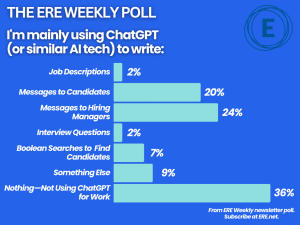Are we sick of talking about AI yet? I know I am. AI doesn’t care that I’m sick of it, though. Technology providers don’t seem to care, either, based on all the marketing messages out there. If there is even a hint of automation, they slap “with AI” on the product description.
Since AI is definitely here to stay, discourse naturally turns toward legal and ethical considerations (of which there are many), as well as the application of it. And this is where things get a little tricky.
If you believe the hype, AI has immediate application in pretty much everything, and it’s going to take over the world, or at least your job. It is already widely used in Big Pharma to help identify new medicines and healthcare to make claims decisions (with about as much success as you would expect). Obviously, if you are a TA leader and haven’t already started implementing AI in your hiring process, you’re already far behind the pack.
Are you, though?
The reality is that technology typically moves at the speed of the slowest common denominator. We are firmly in early-adopter mode right now, with experimentation and exploration in high gear. This is an important stage for innovation but not necessarily a barometer for how the bright shiny new thing might play out.
For every company rushing to incorporate AI into every facet of their business, there is another company that requires a wet signature on their offer letters. For every process that embraces robotic process automation and natural language processing, there is another one that allows public utilities to mail in a paper form to certify a disaster recovery plan, even though there are two perfectly accessible online options to submit it. (Yes, that was a very specific example, but come on!)
It seems that TA is somewhere in the middle, depending on the organization’s readiness. For better or for worse, generative AI is helping teams build job descriptions, job postings, and interview questions. AI is also being leveraged to help source candidates, compiling their experiences to an easily digestible summary for dwindling recruiting teams juggling a high volume of open reqs. Wherever AI has a relatively simple, quick, and seamless integration, recruiting has started to adopt the technology.
But not every recruiting team. And not every organization. Check out the recent poll (below) of ERE Weekly newsletter readers. It clearly shows recruiting professionals are all over the place when it comes to AI, or at the very least ChatGPT and similar technology.

Certainly, there are accuracy issues with ChatGPT, so it’s sketchy to use for analysis. Plus, you have to write really good prompts, which many people have no interest in learning how to do. And really, AI is already being embedded in ATS’s anyway, so recruiters might not need to really explore it anyway. Point is, sentiments and usage are all over the place.
And this is where TA leadership’s frustrations come into play, because the business is reading all of those same AI articles that promise full automation and streamlined efficiency and expect the same experience. Never mind that leadership refuses to invest in new systems, or lacks the patience to wait for process optimization to realize the full potential of the new technology they do invest in. Rock, meet Hard Place.
Talent acquisition leaders, you’ve been here before. You’ve had to navigate emerging technologies, process improvements, economic downturns or upswings, and legislative changes your entire career. It’s why you make the big bucks (ha!).
Your role in this ever-evolving landscape remains one of assessment, education, and advocacy. You will need to be the voice of reason with your leadership team, tempering expectation with reality. You will need to evaluate whether your team and the organization is ready to move into something new. You will also need to help your organization determine moral and ethical boundaries. And you can’t wait for legislation to draw those lines. It’s critical to understand why and how you will use AI and other emerging technologies, establishing a decision-making framework that you can apply now and in the future.
AI is just the latest in a widespread, ever-growing technology pipeline that TA will need to navigate. There will be growing pains and setbacks, triumphs and huge leaps forward. The best thing TA leaders can do in this situation is to keep a critical eye on what is happening without losing sight of the primary goal — finding the best candidates for the organization.
